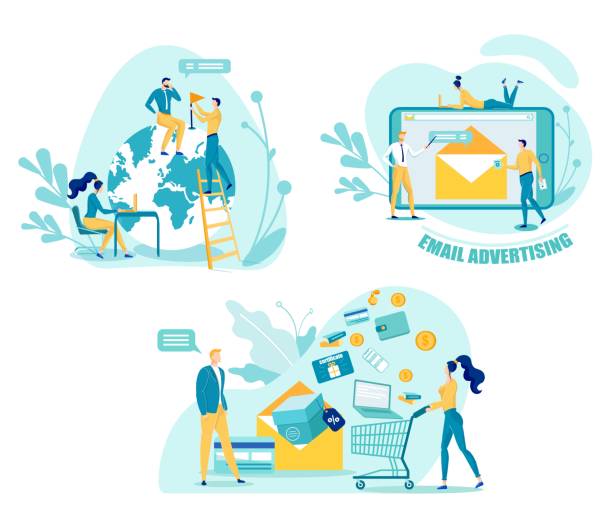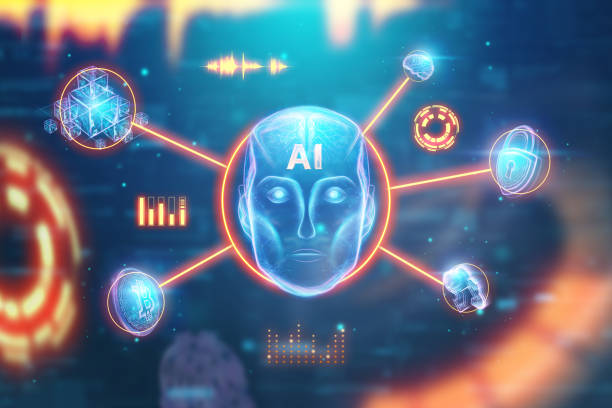Introduction to the Importance of Modern User Interface in Website Design

Today, #Modern_UI_Website_Design is no longer just an advantage, but an undeniable necessity for survival and success in the digital world.
When a user enters a website, the first thing they encounter is the appearance and feel of its user interface.
This #first_impression plays a vital role in the user’s decision to stay or leave the site.
An attractive, user-friendly, and modern user interface not only increases engagement but also significantly improves conversion rates.
In fact, the main goal of modern UI website design is to create an enjoyable and hassle-free experience for visitors that brings them closer to the website’s goals.
This approach goes beyond mere aesthetics and addresses how users interact with the system.
UI/UX design, with a focus on the user, not only encompasses visual beauty but also pays special attention to the logical arrangement of elements, accessibility, and smooth user flow.
In this article, we will descriptively and instructively delve into the concepts and techniques for implementing an advanced and efficient user interface that can meet the expectations of today’s users and differentiate your brand.
The importance of this type of design becomes even more apparent in highly competitive markets, as users quickly abandon websites that do not offer a good experience.
Therefore, investing in modern UI/UX design is an investment in the long-term success of your business.
Does your current e-commerce site design lead to losing customers and sales?
RasaWeb is your solution with modern and user-friendly e-commerce website design!
✅ Significant increase in conversion rates and sales
✅ Strong branding and gaining customer trust
⚡ Get free e-commerce website design consultation from RasaWeb!
Key Principles in Designing an Attractive and User-Friendly Interface

To achieve a #modern_user_interface and effective user interface, adherence to specific principles is essential.
These principles serve as a guide for designers to ensure that the website not only looks good but is also optimized for users.
One of the most important principles is #simplicity and clarity.
Users should be able to easily find the information they need and interact with the website without encountering unnecessary complexities.
The next principle is Consistency; visual elements, fonts, colors, and interactions must be uniform throughout the website to create a sense of familiarity and trust in the user.
Adhering to this principle is very important in web design.
Also, #Instant_Feedback helps the user understand if their operation was successful or requires attention; for example, by changing the color of a button after clicking.
Accessibility is also a vital principle; the design should be such that people with different abilities, including those with disabilities, can easily use the website.
This includes using appropriate color contrast, alternative text for images, and keyboard navigation.
We specifically emphasize that Visual Hierarchy helps users recognize the most important information at a glance and follow a logical path on the website.
These principles are the cornerstone of any successful modern UI website design that not only improves the user experience but also indirectly positively impacts website SEO.
Psychology of Colors and Forms in User Experience
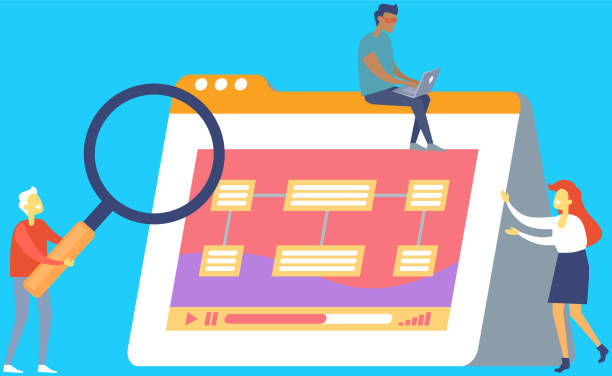
Beyond technical aspects, the #psychology_of_colors and #forms plays a fundamental role in shaping the user experience and visitor emotions.
Each color carries a set of meanings and emotions that can influence the user’s perception of the brand and website.
For example, blue typically evokes a sense of trust and calmness and is widely used in banking or IT websites.
Red can indicate passion and excitement or warning, while green is associated with nature, growth, and freshness.
The correct choice of color palette in modern UI website design can subconsciously guide the user towards desired goals and provide an enjoyable visual experience.
Analytically and expertly, a detailed examination of these concepts shows that forms and shapes also have a similar effect; straight lines and geometric shapes convey a sense of modernity and efficiency, while curves and organic shapes convey a softer and friendlier feel.
| Color | Associated Emotions and Concepts | Common UI Application |
|---|---|---|
| Blue | Trust, calm, reliability | Corporate, banking, technology websites |
| Green | Nature, growth, health, peace | Environmental, organic products, health websites |
| Red | Energy, excitement, urgency, warning | Call to action (CTA), discounts, error notifications |
| Yellow | Happiness, optimism, creativity, warning | Cheerful CTAs, warnings, blogs |
| Black | Power, elegance, sophistication, modernity | Luxury, art, fashion websites |
These choices should be made considering the target audience and brand message.
A correct color psychology can deepen the user experience and create a stronger emotional connection with the user.
Ignoring these aspects in modern UI website design can lead to misunderstanding or lack of appeal for the user, even if the technical aspects are flawless.
New Trends in Responsive Design and UI Animations

The world of #web_design is constantly evolving, and with it, the need for #new_trends in modern UI website design also increases.
Today, websites must be displayed correctly on any device, from small mobiles to wide desktops.
This is where #Responsive_Design becomes a fundamental principle.
Not only must the arrangement of elements be flexible, but images and content must also be optimized for various screen sizes.
This is a technical fact that enables modern browsers to display pages in the best possible way.
In addition to responsiveness, intelligent use of UI animations (Micro-interactions) has also become one of the most attractive current trends.
These subtle animations, such as button state changes on hover, content loading, or visual feedback after an action, not only make the website more lively and dynamic but also significantly contribute to improving #user_experience and #navigation.
Another notable trend is Dark Mode, which allows users to switch the user interface to a dark theme. This feature is particularly useful in low-light environments and helps reduce eye strain.
Also, design with “Neumorphism” elements, which display soft and three-dimensional effects with subtle shadows, or the use of “vibrant gradients” and #bold_typographies, are all part of these new trends.
The goal of these innovations is to create an #entertaining yet #functional visual experience that keeps users on the website longer and encourages them to return.
Correct implementation of these trends requires deep knowledge in responsive design and proper understanding of web animation implementation tools.
These trends indicate the dynamism of the modern UI website design industry, and keeping up with them is essential for every web designer.
Did you know that 94% of the first impression of a company relates to its website design?
RasaWeb helps you create the best first impression by offering professional corporate website design services.
✅ Creating a professional and trustworthy image for your brand
✅ Easier attraction of potential customers and improvement of online positioning
⚡ Get free corporate website design consultation
Essential Tools and Frameworks for UI Designers

To achieve an efficient #modern_UI_website_design, designers and developers need a set of powerful tools and frameworks.
In the #educational and #guidance section of this topic, we will mention some of the most commonly used ones.
In the design and prototyping phase, tools such as Figma, Sketch (for Mac users), and Adobe XD are leading.
These software programs provide extensive capabilities for designing user interfaces, creating wireframes, interactive prototypes, and team collaboration.
They allow designers to quickly turn their ideas into reality and receive necessary feedback.
After the design phase, it’s time for implementation and coding.
At this stage, #frontend_frameworks play a vital role.
Bootstrap, as a popular CSS framework, offers a set of ready-to-use and responsive components that speed up the design and development process.
For building more complex and interactive user interfaces, JavaScript frameworks like React.js, Vue.js, and Angular are superior choices.
These frameworks enable the creation of Single Page Applications (SPAs), which provide a smooth, refresh-free experience to the user.
The use of these specialized tools not only increases development speed but also helps teams align with high industry standards and deliver quality output in the field of modern UI website design.
The correct choice of tools and frameworks depends on the project’s complexity, team’s skills, and specific website needs, but in any case, mastering at least one option from each category is essential for a modern UI/UX designer.
The Role of Content in Completing the User Experience of a Modern Website
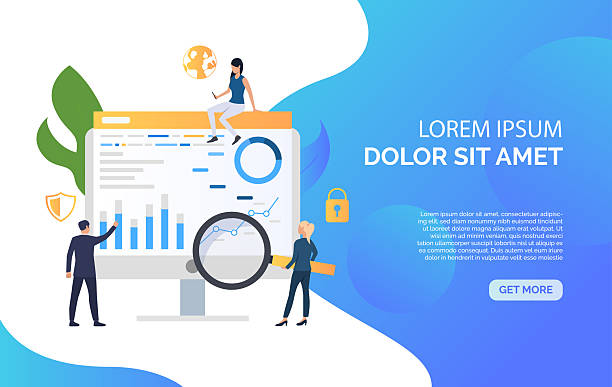
Although #visual_design and #technical_interactions are highly important in modern UI website design, the vital role of #content in completing the user experience should not be overlooked.
Content not only provides the necessary information to the user but also conveys the brand’s tone, values, and personality.
Explanatorily and analytically, it can be said that #UX_Writing goes beyond writing engaging blog posts; it includes all messages, buttons, labels, error messages, and guidance that the user encounters during interaction with the website.
Clear, concise, and useful content helps users easily find their way and complete their tasks.
Using #simple_and_understandable_language, avoiding unnecessary jargon, and focusing on user needs are fundamental principles in #user-centric_content_creation.
Furthermore, organizing content in a logical and scannable manner, using headings, short paragraphs, lists, and relevant images, significantly contributes to improving readability and usability.
Website content should be designed to create a sense of trust and confidence in the user and answer their potential questions.
This includes not only text but also images, videos, and other multimedia elements, all of which should be selected and optimized with the goal of enhancing the user experience.
A website with modern UI website design without strong and relevant content is like a beautiful book without an engaging story.
Therefore, close collaboration between UI/UX designers and content writers is vital for creating a cohesive and effective user experience.
Case Study of Successful Websites with Modern User Interfaces

To gain a deeper understanding of #modern_UI_website_design concepts, examining successful examples can be very #entertaining and #analytical.
Leading websites in the industry often utilize advanced UI/UX principles to create an unparalleled experience for their users.
For example, Airbnb’s website, with its clean and intuitive user interface, easily guides users from the search phase to booking.
The use of high-quality images, an interactive map, and a powerful filtering system has optimized the user experience.
Another example is the Slack website, which, by focusing on #simplicity and #efficiency, provides a professional and friendly communication environment; its minimalist design, clear icons, and advanced search capabilities are its prominent features.
| Feature | Description | Example (Indirect) |
|---|---|---|
| Minimal and clean design | Eliminating unnecessary elements to focus on content and core functionality. | Accommodation booking platform websites |
| Intuitive and simple navigation | Ability to easily find information and different sections of the site. | News sites and portals |
| Fast loading speed | Importance of quick response time to retain users. | Search engines, social networks |
| Responsive design | Correct and optimized display on all devices (mobile, tablet, desktop). | Most e-commerce websites |
| Smart use of animation | Subtle animations to improve feedback and interaction. | Design and art platforms |
Sites like Google Material Design and Apple Human Interface Guidelines are also great references for understanding modern UI website design, having implemented user experience principles on a large scale.
These examples show how, by focusing on user needs, continuous testing, and optimization, designs can be achieved that are not only beautiful but also effectively contribute to business goals.
Ultimately, the secret to these websites’ success lies in the balance between aesthetics, functionality, and a deep understanding of user behavior.
Challenges and Solutions in Optimizing User Interface for SEO

Optimizing the #user_interface for #SEO is a vital aspect that is often overlooked.
Although search engines like Google primarily focus on content and backlinks, a #positive_user_experience and a #modern_user_interface can indirectly and very effectively influence website rankings.
A website with poor UI/UX will have a high bounce rate and reduce the user’s time on the page, sending negative signals to search engines.
From an expert and guidance perspective, one of the biggest challenges is balancing aesthetics and loading speed.
Heavy animations or high-quality images can increase page load time, which is detrimental to SEO.
The solution is to use optimized images, clean coding, and CDN (Content Delivery Network) to reduce loading time.
Another challenge is #accessibility for search engine crawlers.
A website heavily reliant on JavaScript for content rendering might be difficult for crawlers.
Using Server-Side Rendering (SSR) or Prerendering can help search engines better index content.
Furthermore, clear navigation and a logical information hierarchy in #modern_UI_website_design help search engines better understand your website’s structure and identify important pages.
Using SEO-friendly URLs, title tags, meta descriptions, and proper heading structures (H1, H2, H3) all contribute to improving SEO.
Finally, Google’s Core Web Vitals are new metrics that directly focus on user experience (such as loading speed, interactivity, and visual stability) and affect SEO rankings.
Therefore, any optimization in modern user interface should be done considering these metrics to both satisfy users and improve SEO performance.
Did you know that 85% of customers check your company’s website before any interaction?
With RasaWeb, build a corporate website worthy of your reputation.
✅ Increase customer credibility and trust
✅ Attract high-quality leads
⚡ Get free website design consultation
The Future of Modern UI Website Design: AI and Augmented Reality
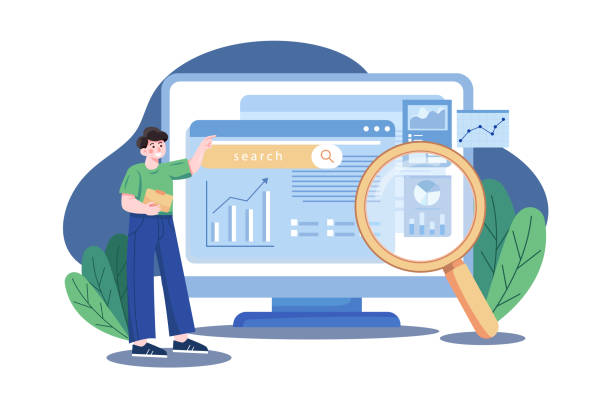
With the continuous advancement of technology, the #future_of_modern_UI_website_design is also taking shape.
Two main driving forces in this path are #Artificial_Intelligence (AI) and #Augmented_Reality (AR), which have the potential for immense transformation in user experience.
As #thought-provoking and #news-worthy content, one might ask: Will websites soon be able to adapt themselves uniquely to each user? The answer is currently “yes.”
AI can analyze user behavior, such as click patterns, time on page, and searches, to provide a #personalized user interface.
This means that each user might see a slightly different version of the website that precisely responds to their needs and interests.
On the other hand, #Augmented_Reality can transform the web browsing experience from two-dimensional to three-dimensional.
Imagine being able to view a product in your home space before purchasing it, or virtually walk through a historical site via a tourism website.
This technology can elevate #user_interaction_with_content to a new level and provide an exceptionally_entertaining and immersive experience.
Also, Voice User Interfaces (Voice UI) are growing, allowing users to interact with websites and applications using voice commands, which improves accessibility for a wider group of users.
All of this means that modern UI website design is moving towards increasingly personalization and immersiveness.
Designers must be ready to work with these emerging technologies and create user interfaces that are not only beautiful and user-friendly but also intelligent and interactive.
These developments bring new challenges for designers but also provide countless opportunities for innovation and creating unprecedented user experiences.
Conclusion and Next Steps for Website Design Professionals
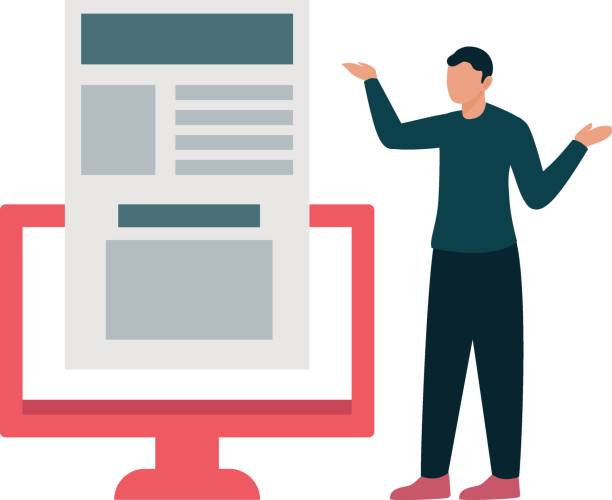
In summary, #modern_UI_website_design is no longer merely an option but a fundamental pillar for the success of any online business.
In this article, we #descriptively and #instructionally examined all aspects of this field, from the fundamental principles of color psychology to new trends in responsiveness, the importance of content, and SEO challenges.
We saw how an attractive and user-friendly interface can not only improve #user_experience but also have a direct and positive impact on business goals and #SEO_performance.
For #website_design professionals, the next steps include #continuous_learning and #adaptability to rapid industry changes.
New technologies like AI and augmented reality are rapidly integrating into design processes, and designers must be ready to leverage their potential.
Investing in UX knowledge, mastering new tools, and an analytical approach to user data are of high importance.
A successful designer in the field of modern UI website design is someone who constantly seeks ways to innovate and create experiences that are not only visually stunning but also deeply fulfill user needs.
The future of web design is one where websites will become increasingly #intelligent, #personalized, and #interactive.
Frequently Asked Questions
| Number | Question | Answer |
|---|---|---|
| 1 | What does modern UI in website design mean? | It means designing a website that has a beautiful, attractive, and up-to-date appearance, while being easy, intuitive, and enjoyable for the user to use (emphasis on UX/UI). |
| 2 | What are the main features of a modern user interface? | Includes minimalist design, ample whitespace, attractive typography, a harmonious color palette, high-quality images and icons, full responsiveness, fast loading speed, and appropriate use of animations and micro-interactions. |
| 3 | Why is having a modern user interface important for a website? | It improves user experience, increases visitor trust, reduces bounce rate, increases user time on site, strengthens branding, and ultimately helps achieve business goals (such as sales or user acquisition). |
| 4 | What is the role of Responsive Design in a modern user interface? | Responsiveness is a crucial component; a modern UI website must display correctly and perform optimally on all devices (mobile, tablet, desktop). |
| 5 | How does typography (font selection) affect a modern user interface? | Proper typography increases readability, defines information hierarchy, and plays a significant role in creating a modern visual feel that aligns with the brand identity. |
| 6 | What is the importance of using Whitespace in modern design? | Whitespace allows visual elements to “breathe,” prevents clutter, enhances user focus on main content, and creates a clean and professional look. |
| 7 | What role do Micro-interactions play in improving a modern user interface? | Micro-interactions (like button color change on click, form submission confirmation message) provide visual feedback to the user, make site usage more interactive and enjoyable, and convey a sense of attention to detail. |
| 8 | What tools are used for modern UI design? | Common tools include Figma, Sketch, Adobe XD, and even Prototyping Tools. |
| 9 | How can one ensure that a modern user interface is also Usable? | Through User Testing, receiving feedback from real users, adhering to Accessibility principles, and Intuitive Navigation. |
| 10 | Does modern design mean removing all graphic elements? | No, modern design means intelligent and purposeful use of graphic elements, colors, images, and animations to create an attractive yet functional experience, not their unnecessary removal. |
And other services of RasaWeb Advertising Agency in the field of advertising
Smart UI/UX: A specialized service for improving SEO ranking based on marketing automation.
Smart Website Development: Revolutionize customer acquisition with the help of marketing automation.
Smart Custom Software: An effective tool to increase sales through user experience customization.
Smart Customer Journey Mapping: Professional optimization for digital branding using custom programming.
Smart Brand Identity: Designed for businesses seeking online growth through the use of real data.
And over hundreds of other services in internet advertising, advertising consultation, and organizational solutions
Internet Advertising | Advertising Strategy | Advertorial
Sources
Principles of User Experience Design
Importance of User Interface in Website Design
Combining Art and Technology in Web
Guide to Modern Web Design Trends
? Ready to revolutionize your business in the digital world? RasaWeb Afarin Digital Marketing Agency offers comprehensive solutions, from e-commerce website design to search engine optimization and social media management, paving your path to online success. Contact us today and transform the future of your business.
📍 Tehran, Mirdamad Street, next to Bank Markazi, Kazeroun Jonoubi Alley, Ramin Alley, No. 6

